[Please Note: Garmin Vector has been released, you can see my first look at it here. In the interest of keeping things clean, I’ve disabled new comments here, and all comments should head over to that post. Thanks!]
Without question the most talked about sports technology product this year at Interbike is Garmin’s Vector, which is a pedal based power meter. There’s been very little information about the device until a few weeks ago when final pricing and availability were announced ($1,500 and March 2012).
However, there’s still been quite a few questions about how Vector will work. So I sat down this morning for nearly an hour with the one person who knows all the answers: Clark Foy. He heads up Garmin’s Vector division, after they were acquired from Metrigear (which he co-founded with Dave O’Neill). Between the time spent with him and then subsequently with Justin McCarthy from Garmin – there was almost 90 minutes of detailed goodness. You may remember my discussion with Clark last year at Interbike.
Crashes, Parts, and Repairs:
Probably the most common concern is around breakage during a crash, primarily due to the potential exposure of the pedal and/or Pedal Bod. Clark started by explaining that Exustar (who makes this Look/Keo-compatible pedal) has virtually no issues with returns on this carbon fiber pedal (based on the PR2 platform) from a damage standpoint – or a failure standpoint.
All moving parts for the pedal are covered under warranty from Garmin. In the EU that’ll be two years, and elsewhere (including the US) that decision is still be made. Of course, one of the biggest concerns many have expressed is that if one managed to break the pedal itself, that the entire $1,500 setup would need to be replaced.
However, Garmin is going to take a parts and accessories approach to pieces of the Vector system (for issues not covered under warranty). The following pieces will be offered as accessories:
A) Pedal Body (outside, the PR2 platform piece)
B) Pedal Cartridge (this is what the spindle lives in)
B) Cleats (both a 6-degree cleat and a fixed cleat)
C) Pedal Pod
There’s still a bit of debate within the team on whether or not A & B above will be considered a single accessory. You’ll note that the spindle itself (where the strain gauges are) is actually not considered an accessory you can buy. The reasoning being they are so confident with the structural pieces surrounding the spindle that should something manage to happen to the spindle itself, they’re pretty much just taking the (customer friendly) stance of replacing it via support.
(Above is the spindle (silver) inside the pedal cartridge)
There’s been a lot of attention paid to the ‘vulnerability’ around the pedal pod, which is the small silver piece that hangs below/off/against the pedal and ultimately transmits the data to the head unit (it’s also where the battery sits).
Many have commented that it seems like a rather susceptible part to breakage should a pedal clip the ground. Clark noted that in some ways it’s actually a bit of an optical illusion as to how close it hangs down to the ground in the event you bank the bike. He said they have yet to actually clip one on the ground and that in every scenario the pedal itself clips the ground prior to the pedal pod – simply due to the angles being discussed.
Nonetheless – should you break the pedal pod, the replacement part is available as an accessory per the above. And while pricing hasn’t been determined – expect it to be in the rough range of $50 (again, rough estimate). He noted that part is in fact very similar to that of a typical Garmin footpod today (ANT+ transmitter, CR battery). These will be sold as pairs (two per pack). It should be noted that the design of the pedal pod is such that the flexible black rubber piece safely breaks away from the rest of the pedal where the spindle is.
Finally, now seems like a good time to let Clark walk through assembly and discussion of each of the different parts of the pedal. So I had him go grab a wrench and disassemble the entire thing right in front of me – explaining each piece along the way. Enjoy!

Garmin Vector being taken apart
Data Transmission, Reception and Head Unit Support:
The two pedals (left and right) that make up Vector work as a master/slave system. The right pedal is considered the master, and the left pedal the slave. From a data transmission standpoint, the left pedal sends data to the right pedal using a non-ANT+ proprietary high speed multi-node network, which is then transmitted from the right pedal to the head unit using ANT+.
When transmitted from the right pedal to the head unit using ANT+, total power is transmitted alongside of % of power of the right pedal (which allows the head unit to do simple math for the left pedal).
In the event the left pedal is broken/removed/stolen/etc, the system will still transmit right pedal power. However, if the unit loses the right pedal it will not transmit power.
From a parts standpoint the pedal pods will from the factory with no specific left/right setting. The unit will automatically detect which side the pod is one upon first use, and calibrate the entire system accordingly.
As noted above, the unit transmits power via ANT+, to all ANT+ head units that support the ANT+ Power Meter Device Profile (i.e. a Edge 705 the same as an Edge 800 the same as a CycleOps Joule). However, only head units that have been updated to understand ANT+ Left/Right power will show Left/Right power.
(Above you can see the Left/Right power displayed as a percentage of total power – above)
Garmin will release by the end of the month an update that will allow the Edge 800 to access this data stream. Following shortly afterwards will be the Edge 500 and the Forerunner 310XT (note: updated this section). Additionally, a new Garmin Forerunner watch coming “this fall” will also have access to the left/right power values. However, the older units such as the Edge 705 will not. I asked why the Edge 705 was excluded and was told that the biggest issue was that the Edge 705 was running on a completely different codebase than the Edge 500/800. This meant that it would have been “a significant engineering effort” – and that from a resources standpoint they decided to focus on other functionality instead of going back to try and update the Edge 705. Again Clark wanted it to be clear that the Edge 705 will display total power from Vector, but not left/right power.
(Note above that the balance – Left/Right power – is shown as Instant, 10s Avg, 30s Avg, and 3s Avg)
Every Vector unit will ship with a Garmin ANT+ USB stick (just like those included in most Forerunners). This will enable firmware updates to the pedals to be done. Clark was rather excited about the prospect of seeing the data coming into Garmin Connect and then being able to optimize changes to the Vector firmware to better the product.
Additionally, he noted that there’s quite a bit more that they can do down the road via firmware to the unit – including pedal stroke analysis, bike/pedal fit (i.e., how you fit left/right within a given pedal/cleat), and more in the areas of balance. He said that there is significant interest from academic groups on studying fatigue, and developing a fatigue metric to see how one changes their left/right balance over time. Today Garmin is already working with these groups in this area and how they can assist.
For those developers in the house, while the current .FIT file format 1.2 does not yet support Left/Right power, they are using an internal version that does and that will be released very shortly. I should have an exact date/day later this evening (they’re just tracking that down with the developer over that piece).
New TrainingPeaks Metrics:
Also note that previously announced – the Edge 500/800, FR310XT and the new Forerunner to be announced will all get the TrainingPeaks metrics of TSS (Training Stress Score), IF (Intensity Factor), and NP (Normalized Power) – on the same timelines as noted above. These will be included within the same update as for left/right power.
(You can see above NP on the top, TSS in the middle, and IF on the bottom)
These metrics will also start appearing shortly on Garmin Connect as they rollout new feature updates (started today for some features). One of the key partnerships with TrainingPeaks was to ensure that the metric seen on TrainingPeaks is the exact same metric displayed on the Edge/Forerunner units, which is also the exact same metric shown on Garmin Connect.
He said that Garmin as a company recognizes that Garmin Connect isn’t for everyone and that the more advanced/elite athletes will naturally go gravitate TrainingPeaks as a platform and that they want to ensure there aren’t discrepancies across the two from a data standpoint.
Pedal Types and Plans
One of the areas folks have asked about is pedal type. Initially Metrigear had planned to utilize Speedplay pedals. Of course they ultimately ended up with rebranded Exustar pedals which are Look/Keo compatible.
The primary reason for this was around their concern for end to end control of the system. Had they gone with Speedplay’s, they were concerned about the support structure due to the nature of Speedplay as a separate company wanting to own that service/support relationship. This meant from a corporate standpoint, it could lead to warranty and support issues. Whereas with the Exustar relationship they went to them with a specific set of requirements and specifications, and came out with a fully branded Garmin pedal – one where they (Garmin) owns the support and warranty chain from start to beginning.
But, this isn’t necessarily the end of the road for other pedal types. Clark let it be known that they’re actively working on both a mountain bike variant and an indoor pedal. He said that “indoor bikes are screaming for power”, and that they hear constantly from companies that serve health and fitness clubs to “get us an indoor pedal for outfitting clubs”. He didn’t have any details to share on the mountain bike side pedal type, though for the indoor bikes it would probably be some variant of a flat platform with an eggbeater built in – but that’s all up for debate at this stage.
He did say from a timing standpoint he hopes to be at Interbike 2012 (this time next year) with both products out and already in the market (both mountain and indoor).
Calibration and auto-zero
There’s been quite a bit of questions around what – if any – calibration procedure would be needed for Vector. Clark noted that unlike most of the power meters today using foil strain gauges, these use silicon strain gauges mounted in glass on stainless steel. With this change they’ve found that additional manual calibration doesn’t need to occur once it leaves the factory. From a product priority standpoint – it’s been their goal that once it leaves, it’s set.
During the factory the unit is calibrated using a dynamic test, as opposed to a static test. This means that in a typical power meter calibration scenario you might hang specific weights from it. However, with Vector, the calibration occurs dynamically such that the weights are placed and the weights are spun around the pedal (with the pedal spinning) at an exact RPM by a machine. This ultimately allows them to measure the response across the entire rotation and then calibrate accordingly. He said it’s very unlikely one would have such capabilities in a non-factory setting. Outside the factory the only other location that will contain such equipment will be Garmin’s Factory Service Centers.
That said, you will as an end user definitely be able to do an auto zero of the unit – either manually or automatically.
Price Point
When Metrigear was first starting out, they were initially targeting a sub-$1000 unit. However, since the announcement of pricing and availability a few weeks ago that has increased to $1,500. He explained that a few things led to this increase.
First was the cost of some of the hardware pieces, and in particular a change to spindle components used that increased the cost. Additionally, they weren’t able to realize the price breaks at the volumes they were initially discussing. He said they are very optimistic that will change in the future and that the savings from a component standpoint could be passed onto the consumers – but that would depend heavily on what the real world volumes looks like from a sales level.
The next factor that added to the price increase was that as a smaller company Metrigear had planned to sell directly to the consumer, whereas Garmin sells to distributors. As a result, Clark notes that there becomes “a reality of stacked margins” – that in effect drives the price up rather quickly.
He noted that his team as as well as the larger Garmin is very aware that in order to move power forward as a more common concept within the cycling world – that Vector price point will have to decrease. And they believe that if volumes can be increased, then the price can be accordingly decrease.
Some have asked if there plans to be a bundle of any sort with the Vector and an Edge device (like the Edge 800). He said there’s discussions about it, but nothing concrete at this time. He did clarify that the rumors some had seen about the $1,500 price including an Edge unit were indeed incorrect. It does not.
Finally, last but not least he noted that we can expect to see Team Garmin using Vector publically going into the ‘off-season’ as well as into the new year. As I noted previously, there is significant concern within the team to ensure that product development isn’t disruptive during the peak of the racing season – hence why it wasn’t shown at the USA Pro Cycling Challenge a few weeks ago in Colorado.
Update #1 (Sept 15th, 2011 12:10PM):
Based on the 25 questions that were left in the comments field (and on the Wattage Forums), I went back to Clark to get your answers. Additionally, I also got two more videos, below. Finally, I’ve got the Garmin guys double-checking everything I write here to ensure it’s 100% correct – that’s always my goal to get it technically correct. Here’s the answers:
Question: “How does heat affect the strain gauges – and should one be re-zeroing often (at all) during a long ride that may start off cool but get hot?”
Vector will dynamically compensate for temperature. These particular silicon gauges have a very predictable response to temperature, in fact these particular gauges are often used in the automotive industry for the same reasons. While Vector does not have a temperature gauge, it has sensing elements. However, the Vector team isn’t detailing this particular piece since it’s somewhat of “a secret sauce”, but did note that it’s “quite effective but unique”.
Question: “What is the autozero trigger by default?”
While there is a clear manual zero process, they haven’t published what the best scheme is as they are still deciding. They need to determine a creative way to catch a zero since there’s always force on the pedal. They have a few ideas but are trying to narrow down what makes the most sense in a broad commercial setting.
Question: “Will there be any way to check the torque value statically in a single orientation (i.e. horizontal with weight hanging to check the tangential force reading)?”
Definitely will do something there, as Team Garmin needs it as well. They are working through the logic of creating a static torque test procedure that’s easy to do in the field. Currently the line of thinking is indeed along the lines of putting the crank in the 3PM position, but still being finalized. Note that Vector is not a torque meter, but rather a force meter.
Question: “To clarify, is it correct that there is just one bushing and one cartridge bearing?”
Yes, correct. One outer bearing, and one inner bushing. I had Clark do a walk through of the full components of the cartridge for your viewing enjoyment:

Inside the Garmin Vector pedal cartridge
Question: “How heavy are the pedals?”
Clark provided the below screen for me to publish. The last column indicates weight against common competitors. A positive value means Vector is lighter, a negative value means Vector is heavier. Click to expand.
Question: “If a portion of the pedal is replaced (i.e. via accessories program) – is there a need/reason the entire thing would need to be recalibrated?
Their trying to determine sensitivity of it to a change like that, but it’s the spindle that gets calibrated. If they determine that it will need some sort of calibration, then it will be handled via support via sending back to Garmin. In other words, they’re still deciding the procedure there.
Question: “Any limitation on crank lengths with the vectors (short or long)?”
None.
Question: “Any limitation on crank width? i.e. 30mm?”
15mm in width and 38mm in height
Question: “Can you detail out the pedal pod a bit more?”
Ok, I asked that question. Yesterday the video file that covers the pedal pod demonstration that Clark did for me got corrupted – so I had him go through it again today:

Garmin Vector pedal pod overview
Question: “When will we see an In-Depth Review of the product here?”
Clark has committed to getting me a Vector unit by the end of the year (complete with a bow-wrapped on it), for testing. Though while I will be free to talk about it – I’ll as usual wait until final release for a full In-Depth review. I do this to allow companies to let me try their hardware while they are still in pre-production (beta) mode without fear of repercussions for publishing pre-production bugs. Once a product is deemed ‘final’, then a review like normal would occur.
Question: “What’s the expected lifetime of the pedal (in particular, the spindle)?”
The goal is “5+ years easily”, but they haven’t published a specification yet. Obviously like all products.
Note on firmware release date
Note there was a slight change to the availability of the firmware dates (which I updated earlier this morning). The Edge 800 will still be within the month, but the Edge 500 and FR310XT will be following shortly thereafter. This includes the TrainingPeaks metrics as well (TSS/NP/IF).
—
As always, if you’ve got any questions (or if you just found this useful), feel free to drop a comment below. Thanks for reading!
—
For the latest Interbike coverage, remember I’ll be tweeting nonstop, so you can catch all the latest action there. And here on the blog you can use this tag to see all the Interbike 2011 posts. Thanks for reading!
FOUND THIS POST USEFUL? SUPPORT THE SITE!
Hopefully, you found this post useful. The website is really a labor of love, so please consider becoming a DC RAINMAKER Supporter. This gets you an ad-free experience, and access to our (mostly) bi-monthly behind-the-scenes video series of “Shed Talkin’”.
Support DCRainMaker - Shop on Amazon
Otherwise, perhaps consider using the below link if shopping on Amazon. As an Amazon Associate, I earn from qualifying purchases. It doesn’t cost you anything extra, but your purchases help support this website a lot. It could simply be buying toilet paper, or this pizza oven we use and love.

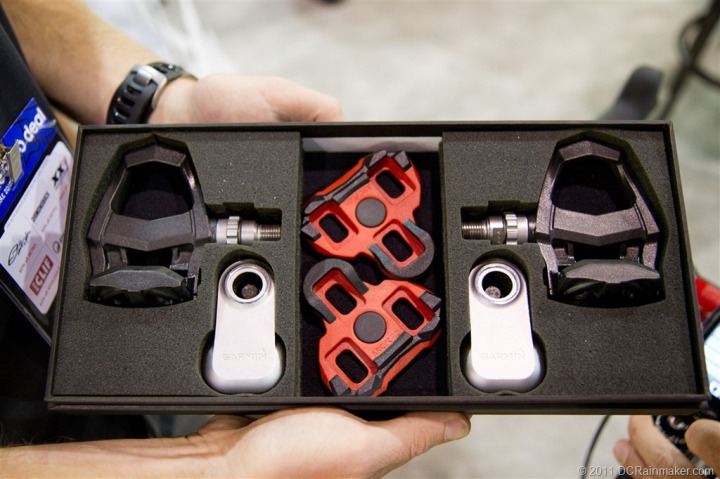


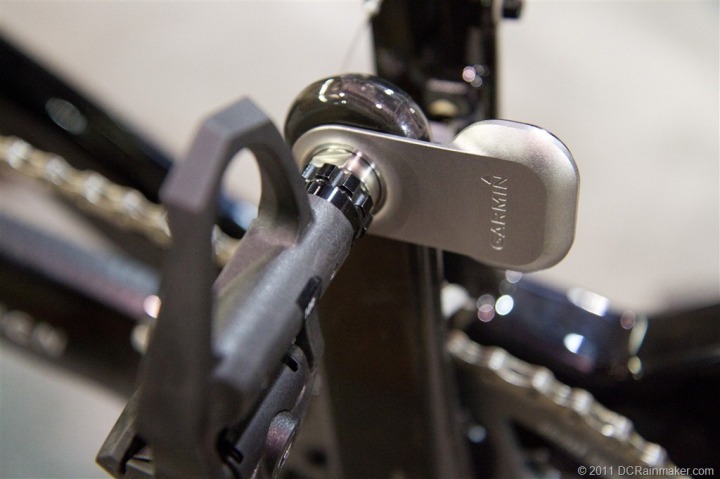
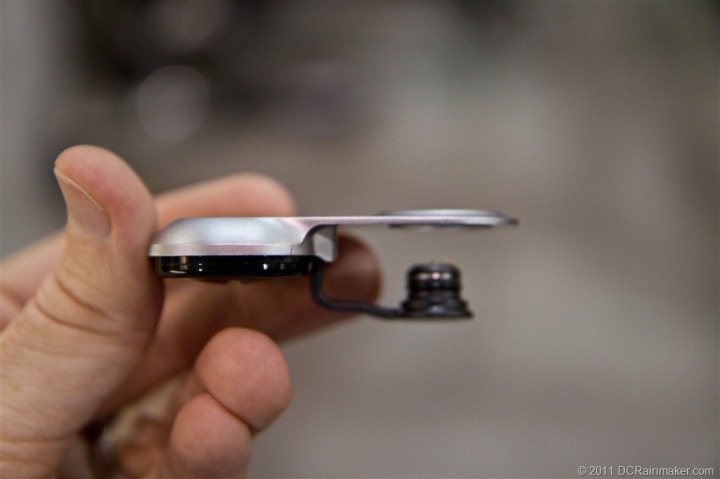
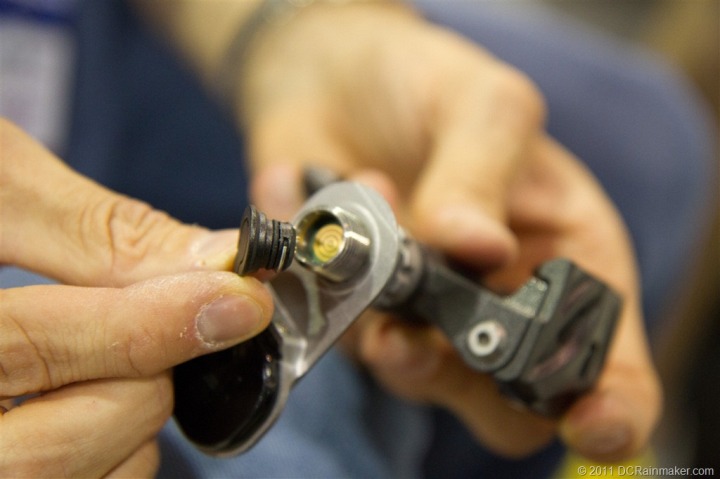
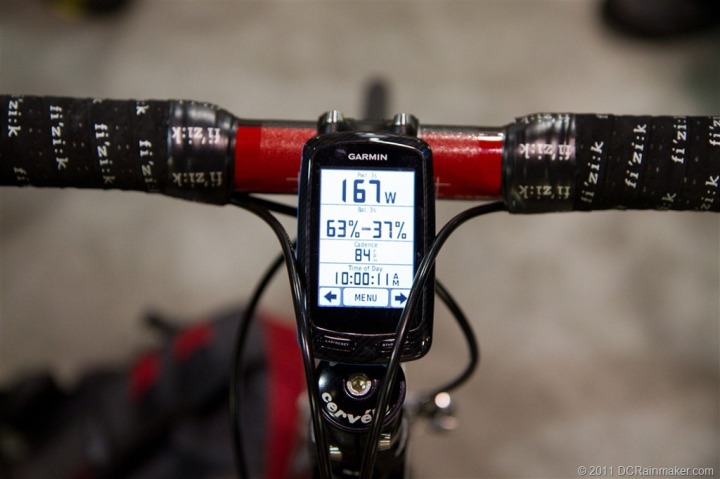
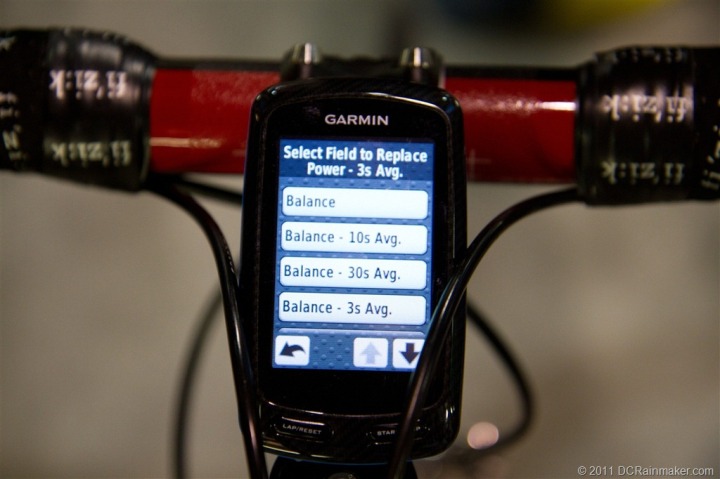
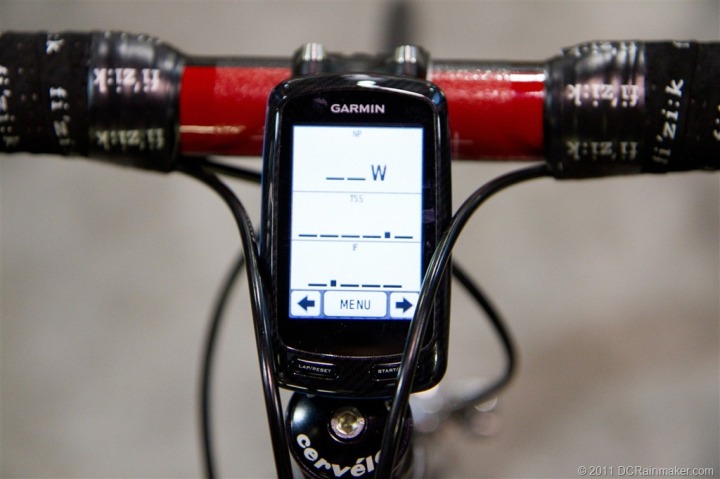
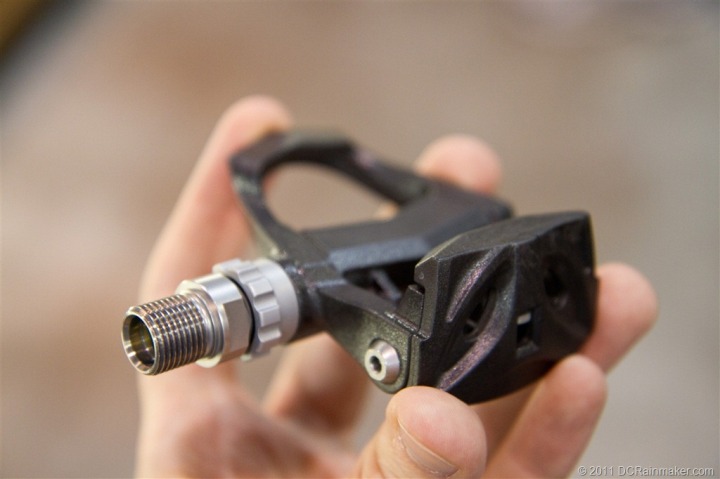
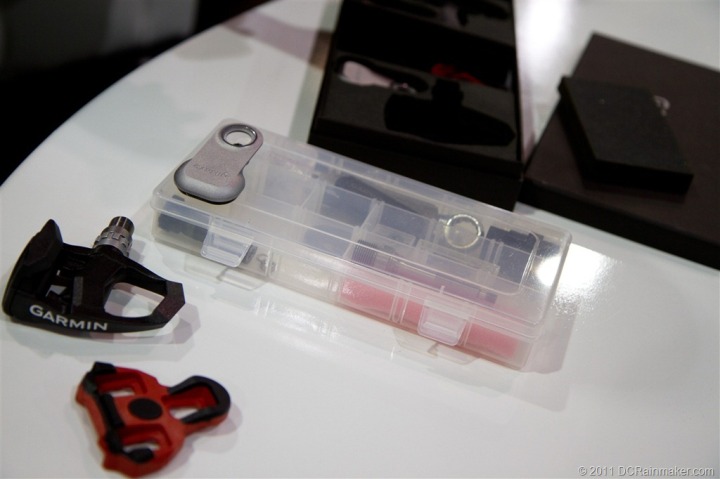
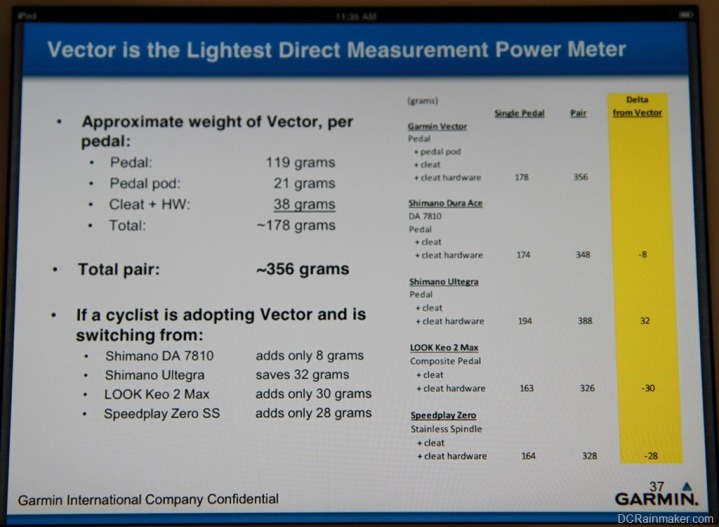





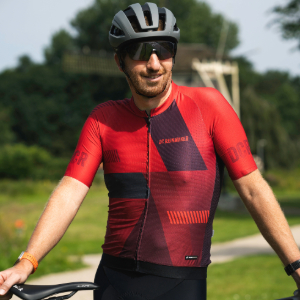














Excellent coverage on your end, Ray. This is why we come to your blog so frequently.
That price point is a deal-breaker for me. I have that kind of money, but I just don’t put that kind of premium on power.
What kind of coaching value is left/right power data? How many watts are to be gained from better balance?
Ditto Chad’s remark. Further, swapping an $800 powertap wheel to another bike takes me 20 seconds. Swapping pedals is more of a pain in the neck.
Seems like the L/R data could be derived from Powertap data with some clever data processing, if one really wanted it. After all, it already derives cadence.
As ever, great job Ray.
705 not getting L/R .. seems like a nice way to get us all to spend more $ on an 800.
Looks really nice tho. Started saving already :)
Glad to see that Garmin is supporting the 310XT, which further cements (to me) that it’s the best triathlon device out there. Of course, as much as I like data (I’m a data nerd, like most pilots), I’m not sure the $1,500 is worth it for me as a middle-of-the-pack triathlete. However, as volume increases, and as technology advances, I like the way things are going – and I definitely see me purchasing this setup in the future (for me, the price point will be around the $500 – $800 mark).
I do like the speedplays, though, and wish they had stayed with them, but understand the decision making process. I would be willing to switch clipless due to the great functionality and compatibility with trainingpeaks.
Kudos to Garmin for continuing support of the 310xt. Best investment I’ve made *after* an Iron-length triathlon :).
Thank you very much Ray for an (as usual) excellent detailed report!
However, I’m not too happy with Garmin’s standpoint here.
They’re too slow to market! March 2012 for the firsta ones, and wait one more year for the MTB and indoor versions?!?
Also, that’s quite a “catch 22” regarding the price and the sales volumes.
$1500 is too much, period!
It will most likely not buy these Garmin pedals. A shame, they could have been so right.
Now I will instead go for the PowerTap.
I’m just unwilling to part from my speedplays. I’ve used looks and look style cleats in the past and they led to knee problems for me. As much as I’d like a system like this, not at the expense of my comfort!
As many others have said I’d rather go with a PowerTap at a lower price point or wait for another technology!
Come on Brimm…
As a coach, I see the L/R balance as perhaps being useful for people coming back from an injury, or people who have some sort of chronic condition. So it’s less of a ‘power-to-be-gained’ metric, more of a tool to help diagnose problems. L/R imbalance can affect more than just total power output.
Pedals are a PITA to switch between bikes, even more so than cranks. So the Power Tap will still be the PM of choice for those not mechanically inclined who regularly ride multiple bikes. I’ll still swap my Quarq back & forth.
Really the Quarq is what this is competing against, but it remains to be seen how accurate & reliable they are. We’ve seen that with the introduction of every new powermeter, including SRM way back in the day. Quarq customer support has been phenomenal so far, we’ll see if the SRAM purchase changes that. Garmin support on the other hand…needs work.
Ray, so Clark said there will not even be a way to check the torque value statically in a single orientation? I’m thinking with crankarms horizontal and with weight hanging on the forward arm. This would allow one to at least check the tangential force reading (the direction that’s important for power calculation).
If that’s not available, I find that to be a HUGE detriment. Many years of experience with MANY types of power meters tells me that you need to be able to at least check the static torque.
I think I heard Clark say on the video that the bearings for the pedal consisted of one bushing and one cartridge bearing. That doesn’t sound up to par compared to the leading offerings from Shimano, Look, etc.
How heavy (or light) are the pedals?
It sounds like the factory calibration is performed on the pedal as a whole, which makes sense to me. If I keep the spindle but replace some combination of the bearings, the cartridge or the pedal body, does it need factory recalibration? Or if I take apart the pedal and reassemble it (with slightly different torque values), does it need factory recalibration?
Thanks for the details!
I have to agree about the speedplay pedals. I’ll be keeping my pedals and my Edge 705, and passing on this device that I waited so long for. Thanks for all of the updates.
Great review, Ray. The price point will keep me away for now.
I’m guessing we can expect an in-depth in the near future?
Hi Ray,
a quick question about the Garmin Vector pedals. Do you know if there is any limitation on crank lengths with the Vectors? I ask this as the Polar-Look pedals originally supported a 167.5mm crank length as it shortest. The latest pictures of the Polar-Looks pedals now only seam to suggest they only now go down to a 170mm length. I ask this as I run 165mm cranks on my bikes.
Many thanks Jonathan
I second TnA´s comment in #8
We have to be able to at least verify the calibration. Running in parallel with another PM seems to be the only option for now :-(
What about any limits on crank arm width with the pods? I’d read somewhere it was 30mm. I have some wide TT crankarms that might be too wide…
Surprised at the comments here, very interesting, and wonder what Garmin will make of them.
Here’s to hoping the new forerunner is a xt/triathlon version…I’ve been waiting for ages for Vector and a new version of the 310!
Great info on the pedals Ray!
Only one thing is bothering me from buying the vector instead of a power2max.
Pedals wear out over time; i understand there are replacement parts, but the bearings in the pedal wear out. Is it possible to replace them without having to buy a new axle with bearings.
What is the lifetime of a pedal, specificly not the body but the axle with al the high-tech in it.
I’m afraid the expensive part of the pedal will wear out in 2 seasons of use and unlike the cranck based you can keep it using.
Defenitly like some anwsers to those queastions?
Thanks again for the great loads of info.
In addition to my post, is it the cartridge that wears out and that everything can be replaced.
The axle with the high-tech in in is solid? and thus can’t wear out?
Or am i not reading it correctly
I really wish this was a lower price. With the price drops on PowerTaps in the last 2 weeks Garmin might find it hard to sell.
$1,500 is a lot of cash and definitely puts this out of the recreational/weekend racers riders range, which unfortunately for us was the prospective client base when these were initially conceived.
My thoughts on Sam’s comments: while the PT can derive cadence, I am not sure it could provide useful L/R data to the user. While it could show you your power at a relative peddle position using some sort of cadence sensor array, the ability to tell you exactly what kind of power each leg is producing would be impossible. Any good cyclist will be doing work all through the peddle stroke and the PT would not be able to tell how much power is being applied on the R leg as you press down versus how much your L leg pulls up.
The fact that I’d need to also buy an Edge device on top of this REALLY makes it hard to swallow when I can grab a PT Wheel with n Edge 500 for $1100.
Thanks Ray – much appreciated for the update.
I had been really keen to see these released and like the concept but I’m unwilling to swap out speedplays (other pedals just don’t have the “adjustability” of speedplay – see link to stevehoggbikefitting.com for one view on why speedplay are “good”).
So, while I like the product and the pricing is ok (ish) I won’t be buying unless they bring out a speedplay version. And it’s dissappointing to me that they can’t sit down with speedplay and talk sensibly about getting a solution that works for both companies.
Thanks for the details. Looks great, but still too much $ and too restrictive on the pedal choice. If it was Speedplay and sub$1000, I’m in. Until then I will stick with PowerTap.
@ Bryce you beat me to it! I’m more excited about the new forerunner. “Additionally, a new Garmin Forerunner watch coming “this fall” will also have access to the left/right power values” can’t believe noone had mentioned that
Thanks for the coverage Ray, this is good stuff! I know that the 705 is not getting L/R data, but is it still true that it won’t be getting nPower, IF and TSS? is this really a code issue? It doesn’t seem like it would be that hard, but maybe it is.
Awesome coverage as always. A couple of things I’m wondering if you have a chance to ask. I understand the 705 won’t be able to display the l/r differential, but will it capture it for analysis in those ASP that support the metric? Are they looking into partnering with any other pedal body manufacturers..say Crank Brothers, to address the MTB CX side of the house?
To answer the Powertap price drops, that is in preparation for release of the new wheel systems.
Great coverage Ray. I’m disappointed that I won’t be in Las Vegas this year, but glad for your coverage. As an SRM Dealer – any response from them? Any information on how to become a Garmin dealer? I have clients on SRMs and many using other Garmin devices who are clamoring for power. As someone who could sell a lot of these… where do I go?
Thanks,
Bob
Kokua Multisports, LLC
How much will an uneven road surface affect the power readings? (I’m thinking from an MTB riders’ perspective even though I know MTB specific pedal is even further down the line.) Also on the Vector website it says “Sees the whole force
profile of pedal stroke” but with max 1 second recording on Garmin devices how will you be able to view/review this? Something later updates will address?
Nice coverage. Thanks! You’re very thorough. BTW, I just bought a Quarq to replace my wired power tap unit. I would have waited for the Vector had it been in Speedplay pedals. That was the deal breaker for me. I won’t part with my speedplays
I totally agree with David, Post #21. I switched from Look pedals to SpeedPlay pedals a couple of years ago, given the unmatched adjustability of the SpeedPlays. With the Vector, my impression is that Garmin totally overlooked adjustability features, including accessories like SpeedPlay’s cleat extender base plate kit, etc. As its business strategy, and rather than partner with SpeedPlay and the other pedal manufacturers, say by providing pedal-compatible power spindles (the heart of the Vector) to all, Garmin decided to enter, and compete with, the pedal business, too. Not sure I understand that business decision — shrinking the size of the market opportunity, while forcing consumers to use their pedal. To say that Garmin wants to control the entire system rings hollow to me …. my guess is that the Vector engineering group likely (and thoughtlessly) won this battle. It’s unfortunate for consumers like me, who have waited for a year or so for the Vector, and are now disappointed by this news, the lack of choice, and are left to re-consider other power meter options again. Whatever happened to mass customization?
Thanks for asking all those questions.
One thing: their supplier is called Exustar, not Exostar.
Art: I don’t know what the story is with Speedplay but I do know that to date Speedplay has taken a strong offensive position against after-market part providers (like Al bow-ties or Ti spindles). The point made in the post is Garmin wants full control over warranty matters which means if any part of the pedal breaks, they can replace it. I think if you want to see these on Speedplay, as I do, you should send Speedplay email asking they cooperate with Garmin on this. Honestly I’m almost surprised they haven’t come down on Brim for producing replacement adapter plates.
Sorry but 1500 USD is definetly to much for this.
It’s a pitty but it appears that garmin misses a big chance to enter the power meter market with a very attractive price.
The potential market would explode and the biggest market share would go directly to garmin.
In this case the best pricing strategy should definitely be volume over value!!
I was sure to buy one but now at this price I will not…
I cannot follow Clark’ s explanations in the interview… He wants to lower the prices as soon as the volumes start to increase, but this will definitely not happen with USD 1500.
I can image that Garmin has a gross profit of ca. 65-75% on Vector with 1500 USD sales price . But lets make the calculation with half of the sales price: With USD 750 sales price the gross Profit would be at 33-38%.
This would be quite an aggressive pricing if you expect a 15% of general OPEX ending to a ca. 13-18% EBIT on Sales. But now the component of the Volumes enter the discussion! I am Sure that with a sales price of 750 USD the volumes would be at least double or triple of the old pricing and this would pay off in the end because the potential market would explode and the biggest share would go to Garmin…. calculate yourself: 1000 units at 75% Profit or 3000 unit at 38% profit…
Keep us up to date on this. Everything I have is ‘crossed’ in hopes that the first generation works like a champ and I can use it in May 2012 @ IM.
Bryce said…
“Surprised at the comments here, very interesting, and wonder what Garmin will make of them.
Here’s to hoping the new forerunner is a xt/triathlon version…I’ve been waiting for ages for Vector and a new version of the 310!”
I am looking forward to more news about the new Forerunner. Come quick, please :-)
Hi there,
great coverage, thanks vm!
If i understand correctly, Garmin states that there is no adjustment for different crank lengths needed. Sounds strange, since the power that actually reaches a bike’s drive train very much depends on where it is generated. Exerting 50 lbs. of vertical power on a pedal that is 180mm away from the center of the bottom bracket will result in different wattage readings than with a 165mm crank, right? Looking forward to your comments on this,
Thanks again,
AW/Germany
A little late for this but maybe you can find out from the garmin people at the ANT meeting. Can they confirm that the vector will work with a fixed gear?
Thank you very much! I wish the pedals can be released yesterday. When will the new Forerunner watch be released? Will that replace 310XT?
@dreale – post 32.
+1 – Garmin needs to re-think price. How is it going to generate the volume it needs to reduce price if potential buyers won’t bite at $1,500.
They’d have a home run under $1k and dominate the market. Come on Garmin!
Thank you for such AWESOME product reviews on both this item, as well as all of the others!
I don’t understand why some people are saying that changing pedals is a hassle. Seems pretty easy to me. No more difficult than swapping a rear wheel.
I see having the power meter in the pedals as a HUGE advantage over the wheel. I have multiple bikes that I ride, but more importantly I have “training wheels” and “race wheels,” and I would want to have power data for both training and racing in order for it to be useful to me. Power metering in the pedals means that I can use them with any/all of my bike & wheel combinations. Very nice!!
– Joe
Buffalo, NY
The addition of the Training Peaks metrics of TSS, NP & IF is a great step forward. Did you learn whether the Edge 800/500 will only calculate them for display or will also write them to the .fit file activity summary for download?
Your comment that Garmin is working to assure the Edge, Connect and TP report the same figures suggests the Edge and Garmin Connect are calculating them independently and thus Connect is not downloading them from the Edge.
I’ve been waiting for these since the initial announcement from Metrigear, and have acquired both Speedplays and a 705. I understand the limitations of delivering L/R to the 705,both of which I have grownto love. But the decision to move away from Speedplay to Look-compatible and raise the target price to that of the Quark makes me feel like I have wasted my time waiting for this product instead of just getting a low-end Powertap. I already think the entire power market is extremely over-priced. I feel like things would have turned out differently had Mertrigear not been acquired by GarmIn. Ultimately, I feel like this is destined to become a product with lots of potential, but lackluster execution. Look at Garmin’s head units for example. Is anybody happy with the way the 705 works? Its interface looks and behaves like something out of 2005. I’m betting we see the same out of these pedals now that we’ve got Garmin “engineering” involved. <\/rant>
Thanks for the info! My biggest questions stem from the accuracy and consistency of the product day after day. It seems there are a lot of inherit issues to overcome when designing a pedal based powermeter–how are pedal velocity, position, and exact calibration between pedals calculated and insured accurate over time? Seems there could be many variables and a large room for error. It’s nice to see there will be torque values displayed somehow but how does the end user know if their unit is actually accurate and stable -especially with a system that is housed in area that is so prone to damage.
You are massively competent and helpful, thank you.
As an ex national class racer and pro, and a racing coach I am concerned about this system.
I think it is a killer that they went with this pedal. This could doom this product.
The racing community feels very strongly about pedal choice. Garmin has taken over and does not understand the needs of cyclists.
The inventors of this product had a better appreciation of this dimension by going with Speedplay at first, a pedal that has wide international acceptance and a proven track record. Even they understood the need to have more than one pedal system eventually.
I do not think that Garmin will be successful with this package. Not selling directly, an unknown and restrictive pedal style and real concerns about dependability serviceability and breakage create a very expensive product.
The real question is why have they not understood the cycling communities needs here? Many young and aspiring cyclists, whom this product could really serve will never be able to afford this product.
Will the only users be teams and well pocketed racer wanna be affluent folks?
Please Garmin, wake up.
Respectfully
Tiderace
The pedal body will need to be replaced every year or two(look uses a metal platform to decrease that wear)This replacement cost should be published at the release.
any information on battery type and battery life?
Great in depth review. These pedals are a game changer, technically superior to SRM/Quarq/Powertap. Can’t wait to get a pair on my bike.
Excellent review, Ray.
I think it a good system for pro racers BUT for an entry level MTB rider like me, who was looking forward to a sub $1000 product it just won’t cut it. The little hanging piece will never last and at a ESTIMATED replacement cost of $50, i think it ridiculous. At $650 the entry level CycleOps Powertap is starting to look more attractive to me.
Newbee
Excellent review. Thanks.
With regard to max crank width, do you know if Vector will be compatible with Power Cranks? I have a feeling that Power Cranks are wider than 38mm. It would be a shame if the device that measures power independently and the device that allows you to train each leg independently were incompatible.
Is it possible to use different crank lenghts for left and right pedal?
Great review of promising new technology.
For those complaining about price, it’s probably set high by design for a first-generation product. I doubt Garmin wants to support large volumes yet and need to work out the real-world problems that are inevitable. The bleeding edge people will pay and will serve as a test bed for the first product. In a couple years, the ‘new’ will wear off, the product will become better and cheaper. Regardless, the lack of pedal choice is a deal-killer for me. I’ll stick with my PT wheels for now.
I switched pedal brands 4 months ago on one of my bikes and slowly transitioned over to Look pedals in anticipation of this release. I’ll be a tester – sure!
Thanks for this most informative write-up. Update on availability. Sutil waiting on FCC approval?
The plan is still March, I should have some more detail that I can share here pretty shortly.
Do you have any info on frequency of measurement…i.e…one second, half second, etc. Any chance there will be the ability to measure from a standing start? Trying to figure the usability for track cycling generally and track sprint particularly.
Mark Tyson
It’s 1-second, which is the current standard for ANT+ devices. They could do burstable to higher speeds via ANT+, but no companies to date have done so.
Like many I have been waiting for news of these power meter pedals. Having just started training on a proper indoor bike with power getting on the road with power would be fantastic. The downside appears to be a change in pedal type, which means another set of shoes as there are only really two of my bikes that need a power meter and of course the cost. Can I hang in there until “volume” sales occur. But then of course US to UK pricing means that they will be £1,500 so can I justify that price as a 210 lb, 23 minute 10 mile time trial rider – not if my wife finds out. One question though I am not clear on is the crank width/height limit, what does this mean – will Garmin provide a list of compatible cranks?
Any news on the release date?
GREAT REVIEW!!
We’re all waiting to know when it will be on sale here in Europe… any news?
Thanks to Garmin for delaying their release until we have all had a chance to sneak $1500 out of the coffee fund. When for Vector? And how long is it going to take to absorb the back order?
Any further news about the release of these pedals, I’d hoped the TDF might have been the platform to release he pedals.
Nothing at this point. I suspect we won’t hear anything more until they are actually available immediately – similiar to the Apple model. That’s somewhat the direction I think we’re seeing Garmin go in, going forward.
I’d expect if there were an announcement, it would be tied to Eurobike (last week of August) or Interbike (mid-Sept).
man, you’re just awesome! i work at a sports shop in brazil, and all of our trainment about gps technology (whe work with Garmin and Polar) are based on your blog! don’t stop helping us haha hank you so much man!
Cool review. How about compatibility with new Forerunner 610?
No, the FR610 doesn’t support the ANT+ power meter device profile. Bummer too, many wish it did.
Hey DC,
Still now futher news on this product ?
Thanks,
Nico’
Nothing beyond it being in the latest earnings calls as Q3 (this quarter). Based on the rumors on the interwebs, I see that as fairly accurate.